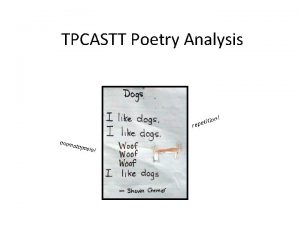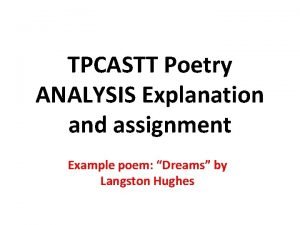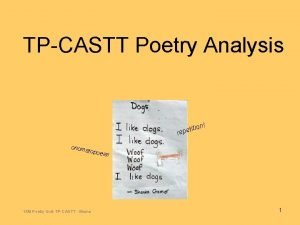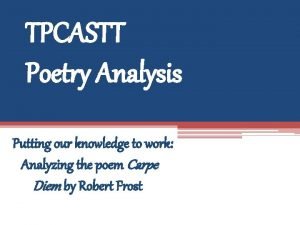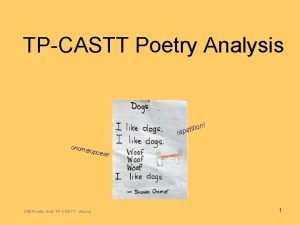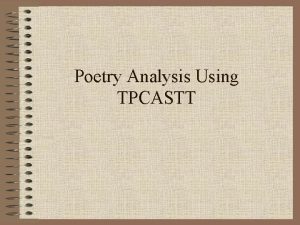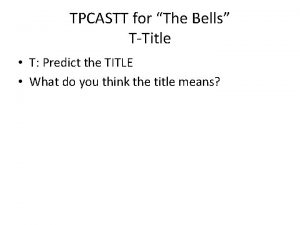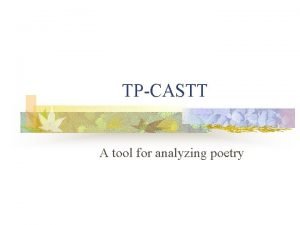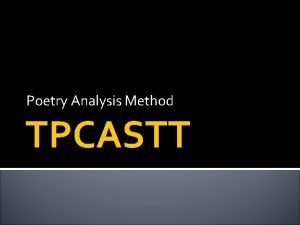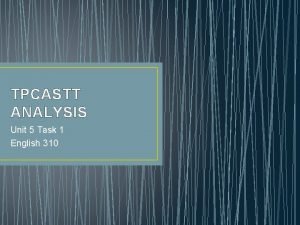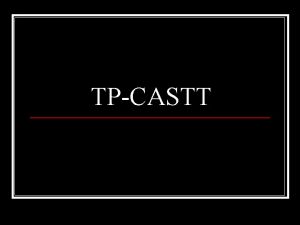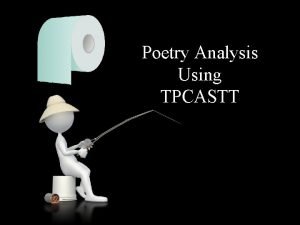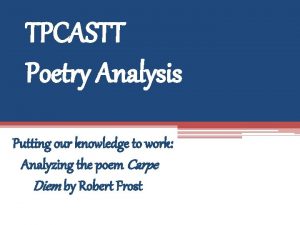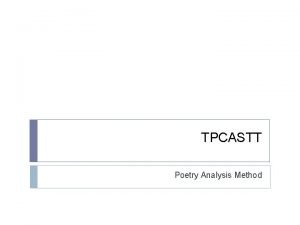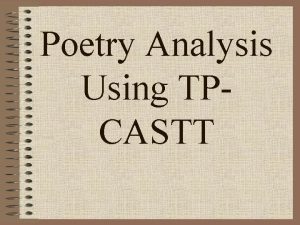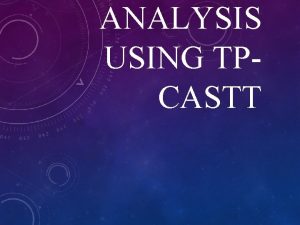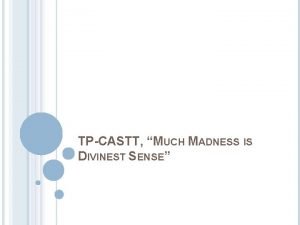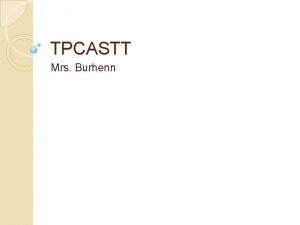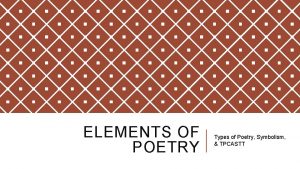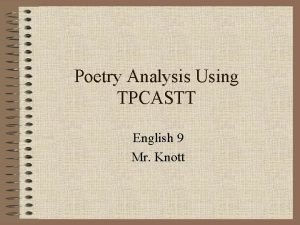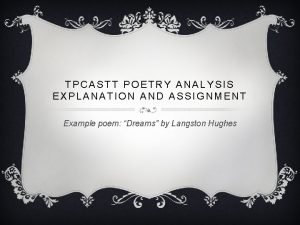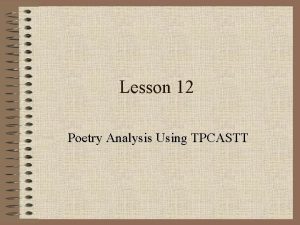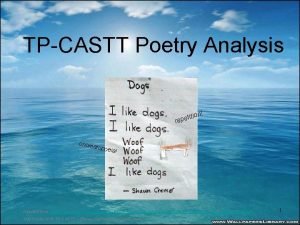TPCASTT Poetry Analysis Putting our knowledge to work























- Slides: 23

TPCASTT Poetry Analysis Putting our knowledge to work: Analyzing the poem Carpe Diem by Robert Frost


Carpe Diem By: Robert Frost

TPCASTT • T-title: The meaning of the title without reference to the poem. You do this prior to reading the poem. ▫ What does the title mean? ▫ Given only the title, what do you think the poem is about? ▫ Does the title convey a specific message/emotion/connotation?

Now you read the poem.

Carpe Diem Age saw two quiet children Go loving by at twilight, He knew not whether homeward, Or outward from the village, Or (chimes were ringing) churchward, He waited, (they were strangers) Till they were out of hearing To bid them both be happy.

'Be happy, And seize the day of pleasure. ' The age-long theme is Age's. 'Twas Age imposed on poems Their gather-roses burden To warn against the danger That overtaken lovers From being overflooded With happiness should have it.

And yet not know they have it. But bid life seize the present? It lives less in the present Than in the future always, And less in both together Than in the past. The present Is too much for the senses, Too crowding, too confusing. Too present to imagine. http: //www. poemhunter. com/poem/carpe-diem-36/

TPCASTT • P-paraphrase: In your own words, what does the poem mean? Do not read into (analyze) the poem. Only read on the surface level. ▫ What is the Poem about? ▫ What is the Plot?

TPCASTT • C-connotation: looking for deeper meaning. ▫ ▫ ▫ Diction and symbolism Imagery Metaphors and similes Rhyme scheme End rhymes and internal rhymes ▫ End stop ▫ ▫ ▫ ▫ Alliteration Assonance Consonance Mood Allusions Punctuation Personification Enjambment

• These are the “sticky” words • Which words stand out to you, or catch your attention?

TPCASTT • A-attitude: Looking for the author’s tone. How is the writer speaking? ▫ Think about the connotations of the words ▫ Does the speaker sound angry? Reminiscent? Sorrowful? ▫ What emotion is the author conveying to you? ▫ Does there seem to be a sense of urgency in the message?

TPCASTT • S-shifts: Looking for shifts in tone, action, and rhythm. Discuss how the shift(s) affects the poem. Mark the locations of shifts in the poem. ▫ Is there a shift in speaker or tone? ▫ Does the time frame (is there a shift in voice from first to third person? )or location change at all?

TPCASTT • T-title: reevaluate the title as it pertains to the poem ▫ Now that you’ve read the poem, what do you think the title means? ▫ Did your impression of the title change at all after reading the poem?

TPCASTT • T-theme: What does the poem mean? What is it saying? How does it relate to life? ▫ What message is the author trying to convey? ▫ What is the author telling his/her audience?

Congratulations!!! You just analyzed a poem!

TPCASTT Example • T: Carpe Diem –means to seize the day; I expect that the poem will discuss the idea that the majority of individuals do not live life to the fullest

TPCASTT Example • P: Paraphrase—the speaker is Age. He sees two young lovers go wandering by. Once they are far enough away that they won’t hear, he wishes them happiness. Age created the saying “Carpe Diem” and it’s poetry’s task to warn against not appreciating life. Many people don’t realize all of the great things they have because they’re too busy living in the past.

TPCASTT Example • C: connotation—”children, ” “go loving by, ” “twilight, ” “churchward”—marriage? , “bid…both be, ” “Age, ” “gather-roses burden, ” “danger, ” etc.

TPCASTT Example • A: attitude—Worried, warning, experienced (he knows what he’s talking about)

TPCASTT Example • S: shift—”And seize the day of pleasure. ' (Shift) The age-long theme is Age's. ” ▫ Shifts from talking about Age as he watches the young couple, to talking about the phrase Carpe Diem

TPCASTT Example • T: Carpe Diem—After reading the poem, the title still gives me the same impression. We should appreciate everything that we have; live each day to the fullest.

TPCASTT Example • T: theme
 Tpcastt example poem
Tpcastt example poem C in tpcastt
C in tpcastt Tp-castt meaning
Tp-castt meaning Tpcastt poem
Tpcastt poem What does tpcastt
What does tpcastt Tpcastt example poem
Tpcastt example poem Paraphrase tpcastt
Paraphrase tpcastt Illustration
Illustration Poetry tpcastt
Poetry tpcastt Tpcastt poetry
Tpcastt poetry I hear america singing poem meaning
I hear america singing poem meaning Black sabbath war pigs meaning
Black sabbath war pigs meaning Connotation tpcastt
Connotation tpcastt Thinking affects our language, which then affects our:
Thinking affects our language, which then affects our: Our census our future
Our census our future Bernadette farrell christ be our light
Bernadette farrell christ be our light Our life is what our thoughts make it
Our life is what our thoughts make it We bow our hearts we bend our knees
We bow our hearts we bend our knees Our census our future
Our census our future Our life is what our thoughts make it
Our life is what our thoughts make it Money madness summary in english
Money madness summary in english Awareness of ourselves and our environment is:
Awareness of ourselves and our environment is: Our awareness of ourselves and our environment.
Our awareness of ourselves and our environment. God our father christ our brother
God our father christ our brother
